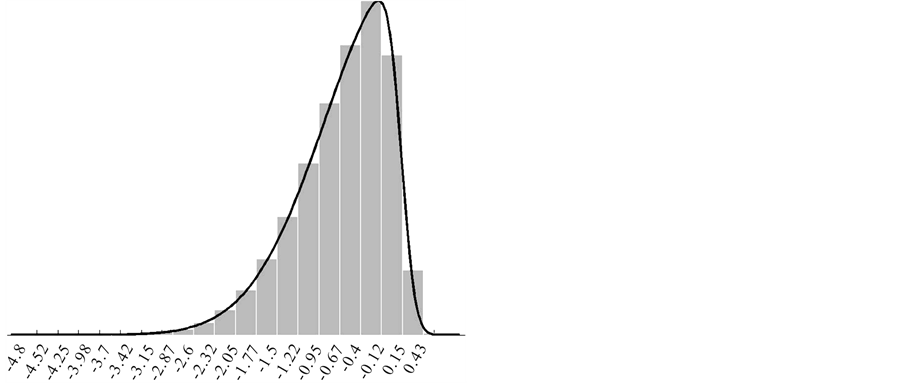1. Introduction
In this paper, we denote by  the skew normal distribution of parameter
the skew normal distribution of parameter  and density :
and density :
 (1)
(1)
where  and
and  denote the standard normal
denote the standard normal  probability density function and cumulative distribution function, respectively.
probability density function and cumulative distribution function, respectively.
The skew normal distribution, due to its mathematical tractability and inclusion of the standard normal distribution, has attracted a lot of attention in the literature. Azzalini [1] , Azzalini [2] , Chiogna [3] , Genton & Liu [4] and Henze [5] discussed basic mathematical and probabilistic properties of the skew normal family. The multivariate skew normal distribution is studied by Azzalini & Capitanio [6] and Azzalini & Dalla Valle [7] . For additional references and a review on related literature, see Azzalini & Capitanio [8] and Pewsey [9] for a collection of papers on the subject. Henze [5] , in his paper showed that if  and
and  are identically and independently distributed
are identically and independently distributed  random variables, then
random variables, then  has the skew normal distribution.
has the skew normal distribution.
For the simulation of the skew normal distribution, we propose a combinations of maximum and minimum of the independent and identically distributed  random variables.
random variables.
2. Method
Let U1 and U2 two independent and identically distributed  random variables and
random variables and  and
and . For simulation of the random variable
. For simulation of the random variable , we take the combination of U and V. First note that:
, we take the combination of U and V. First note that:
• if , the density (1) becomes:
, the density (1) becomes: , simply simulate
, simply simulate .
.
• if , the density (1) becomes:
, the density (1) becomes: , we take
, we take .
.
• if , the density (1) becomes:
, the density (1) becomes: , we take
, we take .
.
For , note :
, note :
 (2)
(2)
We note that: . For simulation of the random variable
. For simulation of the random variable , we take the combination of U and V in the form:
, we take the combination of U and V in the form:
 (3)
(3)
Proposition The random variable X defined in the Equation (3) has the skew normal distribution .
.
Proof. The pair  has density:
has density: , where
, where  is the indicator function.
is the indicator function.
Consider the transformation: . The inverse transform is defined by:
. The inverse transform is defined by:  and the corresponding Jacobian is:
and the corresponding Jacobian is: . X density is defined by:
. X density is defined by:
 (4)
(4)
where . Taking into account
. Taking into account , we can write:
, we can write:
 (5)
(5)
Equation (4) becomes,
 (6)
(6)
For the domain , we have the following three cases:
, we have the following three cases:
Case 1: , we have:
, we have:  and
and 
Case 2: , we have:
, we have:  and
and 
Case 3: , we have:
, we have:  and
and 
Using Equation (6) and the three cases above, we get the result.
3. Simulation Results
We simulated a sample of size 500,000 for the values  and
and , The following Figure 1, Figure 2 and Table 1, Table 2 show the results obtained by our method and the method Henze [5] .
, The following Figure 1, Figure 2 and Table 1, Table 2 show the results obtained by our method and the method Henze [5] .
The results of Table 1 and Table 2 show that our method provides results close to the theoretical values and secondly, we obtain results similar to those obtained by Henze [5] results.
4. Conclusion
In this article we propose a very simple method to simulate skew normal family distribution. The obtained

Table 1 . Simulation results for a sample size of 500,000 and θ = −7.
aby our method; bby the method of Henze [5] .

Table 2. Simulation results for a sample size of 500,000 and θ = 13.
aby our method; bby the method of Henze [5] .
 (a)
(a) (b)
(b)
Figure 1. Histogram of simulations for a sample size of 500,000 and θ = −7. (a) histogram of simulations using our method; (b) histogram of simulations using the method of Henze [5] .
 (a)
(a) (b)
(b)
Figure 2. Histogram of simulations for a sample size of 500,000 and θ = 13. (a) histogram of simulations using our method; (b) histogram of simulations using the method of Henze [5] .
results are very close to theoretical values and the method is more efficient than the standard one. The method is simple to program and exploit for practical applications.